
© 2006-2020 - All Rights Reserved
Probably best to just scroll past the text and look at the pictures. Unless having trouble sleeping. Here we discuss the birds of the brush country of Uvalde Co., with notes on the south Texas specialties occurring. This is not meant to be a treatise on the subject, just a birder's 101 primer.
Much of inland southern Texas is known as the brush country. It is Tamaulipan thorn-scrub habitat, often locally called chapparal. Everything has spines, you need chaps to ride through it on horseback. This habitat extends up to the southern edge of the Edwards Plateau, or the hill country as much of that is called. The mingling of the two very different habitats is a big part of why the great bird species diversity along the southern edge of the Edwards Plateau, where brush-country meets hill country. There are corridors of brush country habitat along the rivers draining the southern Edwards Plateau. These penetrate northward well into the southern edge of the Edwards Plateau, particularly along the Nueces, Frio, and Sabinal Rivers. These habitat corridors serve as funnels for birds coming north out of south Texas or Mexico.

This is how you see everything in south Texas brush-country.
Through sticks and brush. This is a Green Jay. They are
resident north to around Hwy. 90, from Sabinal to Uvalde.
Most of Uvalde Co. is the rolling flatlands of the brush-country, however there is a strip of the Edwards Plateau and hill country across the northern quarter or so of the county. You can see the last big escarpment drop or step of the plateau, 10 or 12 miles to your north, from Hwy. 90. The brush-country itself is a combination of habitats. There are extensive areas that are Acacia dominated with very short vegetation, some areas are 3-6' tall tops. Other areas have nice climax Mesquite woodlands, often areas with Retama or Huisache. Prickly Pear cactus (the Yellow Rose of Texas) is everywhere. Everywhere there are Hackberries and where drainages woodlands of them. More water as along drainages can get Sycamores, willows, live-oak, and even Pecans in the wetter areas. So there are big trees, where water, in areas otherwise without them. Cook's Slough can seem downright lush, plus with cactus. Ft. Inge was lush too until the recent exceptional drought whence it lost many of its big trees. Still good but it really took a beating. Both are great places to see the south Texas and southwestern specialties of the area.

In case you thought I was kidding about how you see everything
in south Texas brush-country... mostly through sticks and brush,
usually spiny. Harris's Hawk is a breeding resident in the
Uvalde Co. brush country.
A large number of south Texas species often (improperly IMHO) called "LRGV (Lower Rio Grande Valley) specialties" are found with regularity around Uvalde (which ain't the LRGV) and Uvalde County. In reality for most of these south Texas specialties, the LRGV is less than a single percent of their ranges, and most are common throughout the south Texas brush country, and far into Mexico. As far as the U.S. goes, "south Texas specialties" would be a much better term, as most of them are widespread in south Texas and not restricted to just the lower Rio Grande valley proper. But congrats to their chambers of commerce.
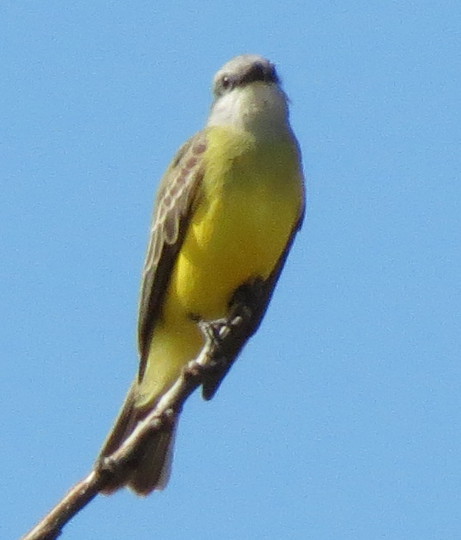
Couch's Kingbird - a wintering bird near Sabinal in 2019.
They often nest at Cook's Slough, Ft. Inge, and the
fish hatchery around Uvalde, rarer in winter, but has bred
and wintered at Utopia up in the hills.
Ferruginous Pygmy-Owl, Chachalaca, and Altimira Oriole are the big three that essentially never happen northward out of the actual LRGV proper and vicinity. Yet so far. And Mangrove Warbler. The oriole and owl get up to the southern parts of King Ranch. Almost everything else can or does occur northward. Most increases in abundance as you move further south, but many qualify for low-density resident status here. Lots of the south Texas specialties are resident north throughout the brush country to the Edwards Plateau. Some are just vagrants to Uvalde Co., but many are resident. Some are rather recent invaders/colonizers this far northward, others have been here for many decades, like Olive Sparrow and Long-billed Thrasher.
Among the south Texas specialty species occurring here in the brush country of Uvalde Co. are Least Grebe, Groove-billed Ani (late summer), Ringed Kingfisher, Great Kiskadee, Couch's Kingbird, Long-billed Thrasher, Olive Sparrow, Audubon's Oriole, White-tipped Dove, and since about 2003 as a regular, Green Jay. This is the northern end of these species regular ranges in Texas. The top of the brush country. All but the Ani breed here (grebe once - ph.). Fifty years ago you had to go to the actual LRGV proper (Falcon to Brownsville) to see that list of species.

White-tipped Dove at Lost Maples. They seem more regular
in the hills at Lost Maples than in the brush country,
but 99.9% of the wooded draws in the brush country never
have been walked by birders.
Good places for the south Texas specialties around Uvalde are Cook's Slough, Ft. Inge, the Uvalde city park on Hwy. 90 in the middle of town, the Fish Hatchery, and along any watercourses in the county (e.g., Nueces, Frio, Sabinal Rivers). Any water crossing area can be good, as UvCo Rd. 202 at the Nueces River. Lower (aka 'old') Sabinal Rd. (Sabinal to Uvalde) is a great birding road crossing multiple habitats with little traffic and lots of birds usually. Most of the county roads offer at least visual access to lots of the habitat, from the edges. Some of the south Texas specialties are found up into the southern edge of the Edwards Plateau, especially where the brush country habitats follow the river habitat corridors up into the plateau. As at Concan and Garner St. Pk. on the Frio River, Chalk Bluff and Camp Wood on the Nueces River, and Utopia and Lost Maples on the Sabinal River. These river habitat corridors of brush country penetrating the hill country are bird highways, with water and cover, that run north-south towards Mexico.

Great Kiskadee at Utopia Park Feb. 3, 2017. They breed
at Ft. Inge and Cook's Slough, the City Park on Hwy. 90
in Uvalde often has them, esp. So. end of park in willows.
Some are present all year where water so they can fish.
Then there is also a great selection of birds many think of as 'desert southwest' specialties, which are at the eastern end of their ranges in the brush country of Uvalde County. Here they are residents of Tamaulipan thorn-scrub, the brush country. Which is much lusher than what they use in the west. As you move west they are found in Chihuahuan and Sonoran Desert. Though many at the west end of their range (AZ) are a different subspecies (NW Mexico type) than what we have here in Texas (NE Mexico types). Some of the 'desert southwest' species found here include Scaled Quail, Harris's Hawk, Verdin, Curve-billed Thrasher, Pyrrhuloxia, Black-throated Sparrow, Cactus Wren, Brown-crested Flycatcher, Bullock's Oriole, Bell's Vireo, and if it rains (usually) Cassin's Sparrows. All are widespread breeders in the brush country of Uvalde County. In the western (dry) side of the county, Black-tailed Gnatcatcher occurs. And yes of course Roadrunner can be anywhere. Seeing one when you need one is another story. So there is a fairly full complement of species most think of as SW US desert species, in the brush country here.

Olive Sparrow is resident in the brush country, breeding
north into the hills at Utopia and Lost Maples in recent years.
Easier to hear than to see, but some are quite tame.
So a bunch of sorta 'desert southwest' species are residents, or breeding season residents here, as well as many of the south Texas specialty species. A few other items perhaps of interest for perspective on common birds in the area... The default waterfowl is Black-bellied Whistling-Duck. In spring and summer, common are Vermilion (only few in winter) and Scissor-tailed Flycatcher (April-Oct.), Painted Bunting (late Apr.-July), and Orchard Oriole (late April- Sept). Zone-tailed Hawk nest in Uvalde (in town), and probably in Sabinal, as well as any patch of big trees. Lesser Nighthawk also nests in Uvalde and Sabinal. Check any lights after dark along Hwy 90, e.g., gas stations.

Long-billed Thrasher is a resident breeder throughout,
north to the plateau, sparingly into the hills at least
to Utopia area.
There are other south Texas or Mexican species that are possible as vagrants, or occasional kinda probably not even really vagrants. Actual colonizers might be a better term for some. Tropical Parula provides annual singing males at Concan, at least one fall migrant at Cook's Slough, and a number of records along Sabinal River including one winter record, about 5 spring-summer of 2021, and apparently bred at Lost Maples in 2022. Rufous-capped Warbler has had multiple temporary colonists including pairs at Concan and multiples at Chalk Bluff, several in or adjacent to Sabinal River drainage, etc. Both of these warblers are trying to gain a breeding toehold at the edge of the plateau. Pauraque is being found in Uvalde Co. now, mostly in the brush country but four records now around Utopia. Elf Owl is present along some parts of the Nueces River in summer. White-tailed Hawk has occurred several times in recent winters along Hwy. 90 and around Sabinal. There are nearly annual Short-tailed Hawk records recently in spring.

Audubon's Oriole are sparse resident breeders in the
brush country along watercourses where big trees, and
up into hills to Utopia and Lost Maples, surely elsewhere.
It appears most vagrants here are likely of Mexican origin, and just about anything can happen. There are two recent Rufous-backed Robin records from around Uvalde (Feb. 2011 at Ft. Inge and maybe Jan. or Feb. 2019 at C.R. 202 at Nueces R.). There are at least four Clay-colored Thrush (was Robin) records now (two at Cook's Slough, two at Utopia) recently. A family group (breeding!) was at Uvalde City Park summer 2022. A Yellow Grosbeak wintered 2018-9 at Concan. A Bare-throated Tiger-Heron also occurred recently at some top secret site in the county (I don't know where). There are Gray Hawk and Red-billed Pigeon records here in UvCo. I saw a White-collared Seedeater once (Utopia), heard one singing another time (Ft. Inge cane patch). Also heard a Yellow-green Vireo singing near Sabinal one July. Common Black-Hawk (at least one ph.) is known from Uvalde County, and there are records for Tropical Kingbird and Painted Redstart. Some vagrant hummingbirds in Uvalde Co. are Lucifer, White-eared, and Mexican Violetear. So anything can happen, as the first U.S. record ever of Collared Plover at the Uvalde Nat'l. Fish Hatchery showed way back in the 1990's. Keep in mind UvCo is further south than some of Mexico. Don't expect any Mexican vagrants, but they do happen here.

Ringed Kingfisher may be seen at any water in the county.
Surely breeding on Nueces, Frio, and Sabinal Rivers now.
This is a sub-adult female.
There is much we don't know about the northward explosion of many south Texas species as it is unfolding right now in front of our eyes. It is an unprecedented event, so we have little to base even speculation on. Brush country birds are moving into the hill country. Lower Rio Grande valley birds are occurring as vagrants. Mexican vagrants that some thought might occur in the lower valley occur here now. There is wholesale level change occurring, here and now. It is to me exciting times to be birding here.
I no longer do guiding, sorry! Leaving this for posterity: In case of interest, I am available to guide trips (takes 8-9 hrs. minimum) birding around this unique wonderful brush country thorn-scrub habitat in Uvalde County. I love it myself. Unless it is raining bad.
Besides the residents, in winter in the ag fields, if you can find the right ones, you might find Sandhill Crane, White-fronted Goose, and Mountain Plover sometimes, if you can find them. Maybe Sprague's Pipit too. Often lots of sparrows and usually lots of raptors as well. Spring to fall is best for ease of finding the south Texas specialties, when they are singing or with young. Some can get quiet in winter, especially if weather inclement.
Below the photos below is more discussion with a couple short essaylets expanding on a few more thoughts and ideas about brush country birds and birding in Uvalde County, some historical notes about the birds and the birders presence here in UvCo., and the Ravens here.
Finally... some photo fun...
Here are some mostly poor pictures of a few of the brush country birds of Uvalde County. During a recent wholesale revision of the page, many poor pix were removed though some were left up simply because they were docu shots of a rarity.

This is an adult Harris's Hawk near Utopia, rarer
up on plateau but nest in brush country right off it.

Least Grebe at Uvalde National Fish Hatchery
The hatchery and Cook's Slough are best bets.
I have a photo of an egg from Cook's Slough.

Here is a better pic of a Least Grebe, this one near Utopia at the golf course pond by the Waresville Cmty. Photo Aug. 30, 2020, two months into its visit. Said to be 9" long, book measurements are often of a museum specimen with neck stretched out. You would swear if you saw this bird all 4 oz. would fit in the palm of your hand.

Couch's Kingbird - docushot of an adult feeding one of 3 young
fledged in Utopia on June 5, 2006. One of the further north
known nestings and maybe the first ever for the species
up on the Edwards Plateau - in the hill country

Groove-billed Ani is a late summer and early fall visitor at places like Ft. Inge, Cook's Slough and the Uvalde National Fish Hatchery.

Check out that groovy bill man. They look prehistoric.

Audubon's Oriole - docushot first Uvalde Christmas Bird Count
record, December 2004, a second-winter bird. In winter look along
watercourses, but resident all the way up to Utopia in NE county
hills. Lately seeming resident at Lost Maples too.


First documented Clay-colored Thrush in Uvalde Co.,
at Cook's Slough, Feb. 4, 05. The second was in Utopia
on May '08, a third 150' from the where this
first one was at Cook's Slough in Feb. '12! A fourth
was at Utopia Park an entire February. Like Rufous-backed
Robin, there are way more of these skulkers around than detected.

Rufous-capped Warbler, this was the male of a pair at Neal's Lodges in Concan for 6 months plus, but never seen after the ice storm of '07. Since about 2018 or '19 they have been seeing one or more and I think maybe a hybrid, at Chalk Bluff Park on the Nueces River, south of Camp Wood. There are surely many more of these around than are detected.

Here is a pic Bob Doe got of the Rufous-capped Warbler I found
at Lost Maples, his pic a couple days later on Sept. 29, 2015.
Thanks Bob for letting us share your great photo!

Tropical Parula, this male was territorial
at Utopia on the River for 6 weeks.
This (below) was one of five that summered near Utopia in 2021.

This is a Tropical Parula. Note black mask, no broken
white eye-crescents, yellow malar, and no black or rusty
band across upper breast.

One of the Green Jays at Utopia winter 2008-09! Regular
in Uvalde Co. since about 2003, has bred at Ft. Inge and
Cook's Slough.

Hooded Oriole in mid-March - check any palm tree
you see spring to summer.

Long-billed Thrasher - look in dense brush along any watercourse
up to the edge of the plateau, such as at Concan, but rare up in
the hills shortly past that. Cook's Slough and Ft. Inge have lots,
but often harder in winter.
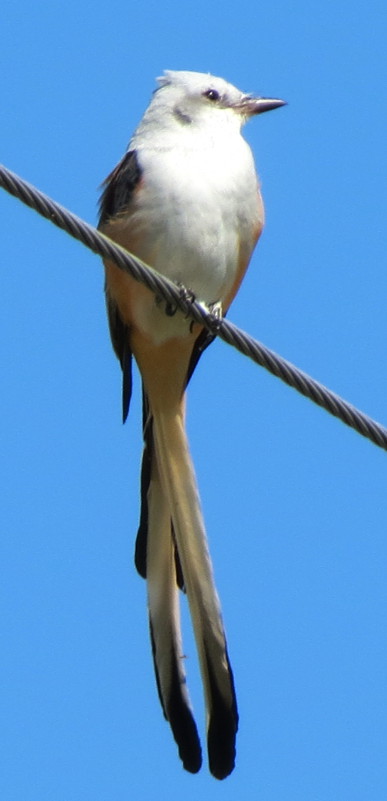
Scissor-tailed Flycatcher, male. Very common breeder, absent in winter.
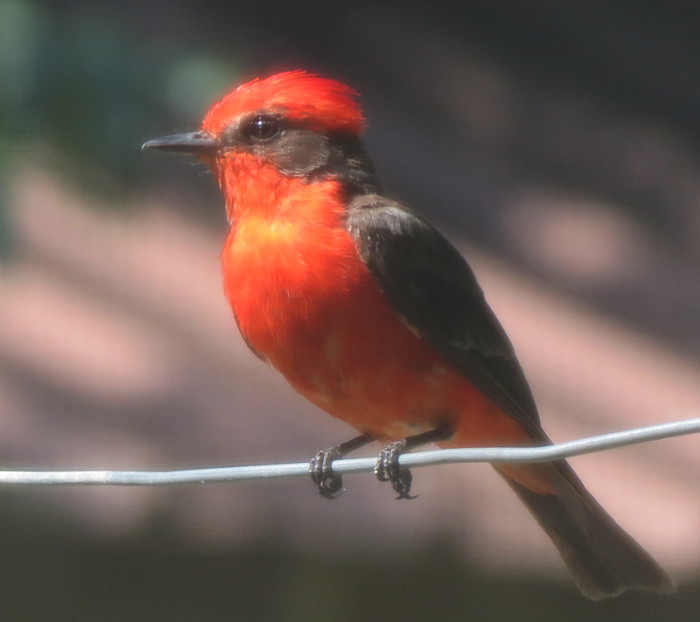
Vermilion Flycatcher - the brightest bird in the brush country.
Common and widespread, but only a few usually near water in winter.
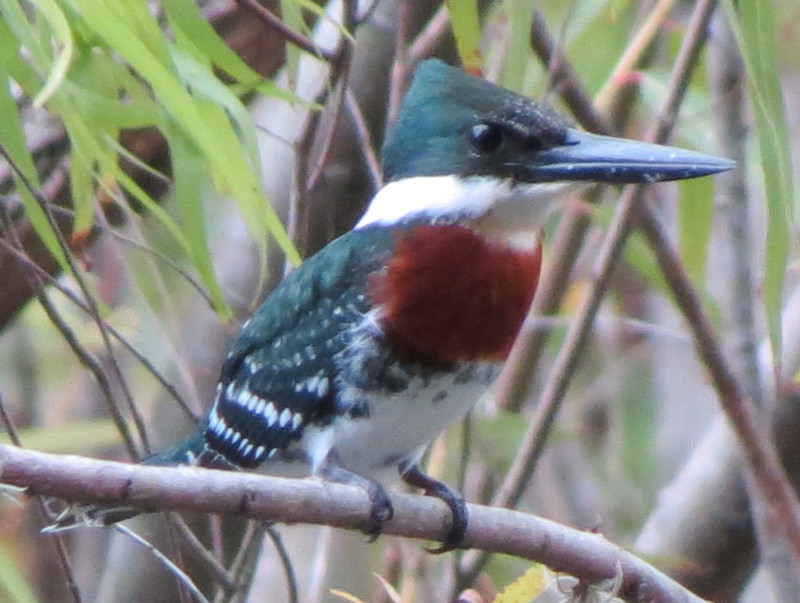
Green Kingfisher could be seen at any water in the county.
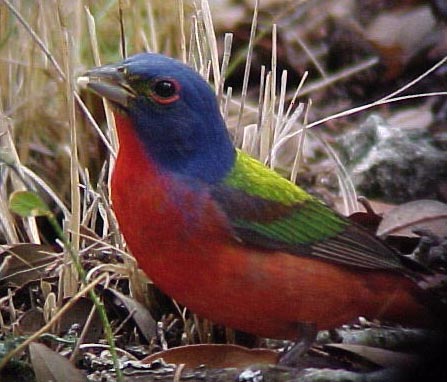
Painted Bunting - A very common brush country denizen usually
along draws and watercourses, present late April through July.

The opposite of a Painted Bunting, a Cassin's Sparrow.
Common breeder most years in the brush country. Has nested
at Cook's Slough (on high point), and usually along
Lower Sabinal Rd. south of Hwy. 90.

Verdin is a common widespread resident of the brush country
of Uvalde County, ranging north into the plateau hills in winter.
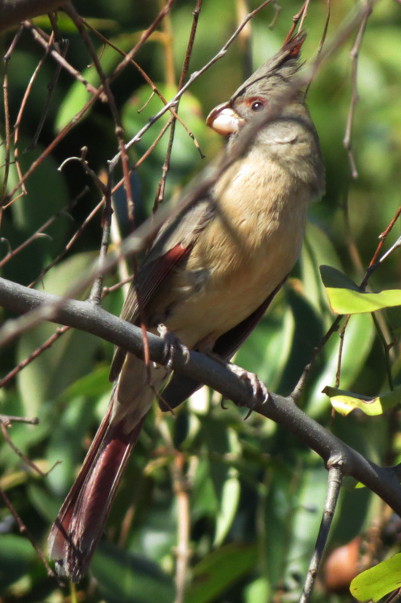
Pyrrhuloxia is a breeding resident in the brush country,
and interestingly moves onto plateau in winter some years.
Note rounded horn yellow bill.

You could see a Black-throated Sparrow virtually anywhere
in the brush country. Uvalde Co. Rd. 202 might have them.
Has nested near Neals in Concan, and at Utopia, but west dryer
side of county better for them.

Caracara is a common resident in the brush country, and up into
the plateau. They can rapidly change color of facial skin,
as a Roadrunner can. This one is all jacked up.

Roadrunner you could see on any road in the county. Look at
that drumstick! I bet that is the toughest drumstick in America.
You will never get tired of these near-Jurassic beasts, until
you see them going after hummingbirds at the feeders.

This is the Cactus Wren that was at the pond on the golf course by the Waresville Cmty. Nov. 1, 2020. Bad light, I know, but my first local Utopia area Cactus Wren photo. Fairly common around cactus down in the brush country, but rare and local on plateau up in hills.
~ ~ ~
We will add some more pix as I get or find them. Hopefully we have given a better idea of the brush country birds of Uvalde County. Lots of south Texas, and southwestern U.S. species both call the area home, making for some great diversity, and darn fun birding. There are only a half dozen pin dots that get any coverage in the county. Most of it is never looked at. And every time someone looks they see something interesting.
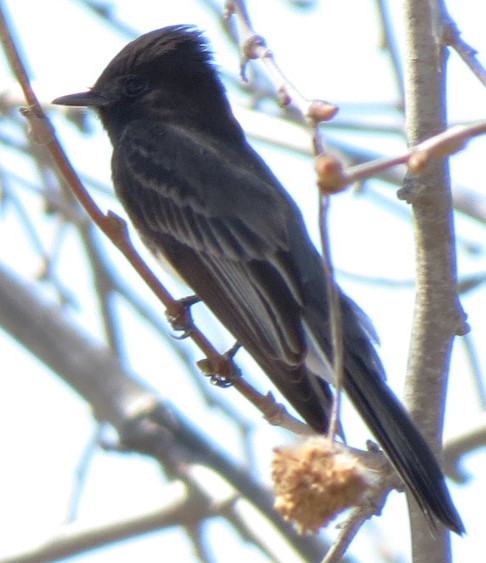
Black Phoebe Feb. 25, 2020 at Nueces River in Uvalde.
Sorry about the pixels, camera settings flew off again.
Black Phoebe is fairly regular along Nueces River in
western part of Uvalde Co., and often on the Frio River.
but getting rarer quickly eastward. Around Utopia several
pairs were breeding here 2003-2008. When the big drought
set in they departed and have been rare here the last decade.
Utopia had a pair at the park spillway and 1050 bridge,
a pair bred at Lost Maples, they are very rare on the Sabinal
River now. There may still be pairs at Concan and Garner on
the Frio River.
~ ~ ~
Following are some more detailed essaylets expanding on some of the things touched above... and some things not yet covered...
Some modern Uvalde County birding history.
I welcome information regarding the UvCo birding history. There is very little in the published record that I can find. If you know some UvCo birding history, I would love to hear about it.
Following are some modern historical Uvalde Co. notes on birding here. Lytle Blankenship lived in Uvalde and birded the county hotspots for 25+ years from the 70's to early oughts of the new millenia. He was the pioneering birder of coverage in Uvalde County. He was the first Uvalde Christmas Bird Count compiler and, senior author of the first real Uvalde County checklist, in 2002. Which was a single quad-fold double-sided legal page, worth ten times its weight in gold. Co-authors were Sue Weidenfeld and June Osborne. It was great. Sure glad I got one. But I have marked it all up.
Prior to Lytle, the one and only late great Jim Lane deserves some credit for some of the first national level widespread promotion of Neals Lodges in Concan as a par excellance birding location. It was originally mentioned in the first Birder's Guide to the Rio Grande Valley 1972-3 or so), in the Edwards Plateau loop. Neals Lodges is quintessential 'brush country meets hill country'. That guide was co-authored by John Tveten, a (late) great Texas naturalist, that probably showed it to Jim. John was a regular leader for Nature Quest field trips when that festival was run out of Concan. He was a one-of-a-kind naturalist, like Jim was. As a funny aside... the last time I saw Jim Lane, at dinner he said to me "have you been to Concan? GO to Concan, you'll LOVE Concan". It was the words of a prophet. He would have cracked up to know I ended up living in the vicinity.
Then more recently from the 80's I think through the oughts, June Osborne was a great champion of Concan having a birding residence at Neals Lodges a month or so each spring. She wrote a wonderful loose-leaf booklet about bird-finding in the Concan area, which covered much of Uvalde County. As well as articles about it in national bird magazines. More recently, certainly the first decade or so of the Nature Quest festival when based in Concan helped make the area much more well known to many birders too. Now about a half-dozen hotspots in Uvalde Co. get at least some bit of coverage, and actually quite a bit compared to much of the counties history prior in the last millenia. The last almost twenty years since the new millenia, it has had coverage at levels never known prior. Still 99% of the county is not looked at 99% of the time. At the half-dozen hotspots that get some coverage, most of it is during three months from spring to early summer when the birder tourist season is at a mild roar.
~ ~ ~
On the current northward expansion of birds.
To help put the current situation of south Texas birds' northward bird expansion in perspective... as of Lytle's 2002 UvCo checklist, they had no White-tipped Dove record, he knew of two Audubon's Oriole and a few Green Jay records (of singles) in the county. That was it. Then winter of 2003 (I moved here fall 2003) on the Uvalde CBC I found the first flock of wintering Green Jay (5) and the next year on the 2004 CBC the first two Audubon's Orioles they ever recorded, both were at Ft. Inge. Both of which appeared in subsequent years. The Green Jay appears to be nesting there, not leaving in summer within a few years of discovery. I have had begging young at Cook's Slough since as well. Then in winter and spring of 2008 the Green Jays invaded north ONTO the Edwards Plateau in numbers for the first time ever. There were several dozen on the plateau to Leakey, Concan and Bandera amongst other places!! Finally, winter 2009 the first 3-4 were at Utopia a month plus at a (deer) corn feeder!
South is moving north. Winters are milder, birds restrained by the cold move northward. And upslope. Seemingly progress is around a couple miles per year on average. Olive Sparrow has long been known from Cook's Slough, Ft. Inge, and Concan. Now it nests all the way up the Sabinal River to the headwaters at Lost Maples SNA in Bandera County! Several White-tipped Doves were found (spring, summer and winter) 2003 to 2012 around Uvalde County. It has exploded northward since 2012 with multiples at Lost Maples, Park Chalk Bluff, in Real Co., singles in Utopia last several years. It is now breeding at Lost Maples SNA in Bandera County since about 2016-17 or earlier. It may take birders to detect the Olive Sparrow invasion, but these hill country people darn sure would have noticed Green Jays at their deer corn feeders before. The Olive Sparrow and White-tipped Dove are nesting at around 1700' altitude now at Lost Maples!
More recently I had a Roadside Hawk winter around Utopia, and return another winter! I could never get a photo or nail it down to a location but saw it a half-dozen times very well. I can't even tell you about everything I have seen. Will mention I have seen Aplomado Falcon here. In a decade or two, things have changed radically, so far. I expect this will intensify. More Mexican vagrants are showing up here in Texas, and in Arizona for instance, and further north. Some in other states. We will see more here too. Besides a few hundred to a thousand acres, in Uvalde County almost all of the county, and everything between it and Mexico, remain unlooked at, almost all the time. We really only have a very foggy idea of the tip of the iceberg of what is going on here.
~ ~ ~
~ ~ ~ a note on the common Common Ravens here ~ ~ ~

Common Raven - all Ravens along the southern edge of the Edwards Plateau, including out into the brush country to at least Hwy. 90 should be considered Common until PROVEN otherwise.
I had a note here about how there were some Chihuahuan Ravens here. But thanks to this internet thing, I can change things as things change. The first few years I was here there were a few resident Chihuahuan Ravens here in the flatlands of the Sabinal Valley. The Ravens I encountered at Ft. Inge, and in the brush country to the south, were Chihuahuan. Since the exceptional seven year exceptional drought (roughly 2008-15, but unrecovered still) they have been absent. I have seen only a few fall migrants. A very few. To update, I have seen no Chihuahuan Raven locally in a few to several years now as of the end of 2019. If you can see limestone cliffs of the Edwards Plateau in this south central part of it, the ravens you see are Common. These are small compact Common Ravens, but listen to them. They will tell you what they are. Common Raven are now very common residents along the southern edge of the plateau in all the major drainages, breeding at seemingly any and every available cliff habitat, and also in Cypresses along rivers. Possibly in big live-oaks as well.
As a rule I'd have said until a few years ago, the flatland brush-country Raven sightings should be considered Chihuahuan first as the default, and once up in the hills of the plateau where cliffs and rock outcrops are visible, then Common become the default Raven. As the drought set in, first I started seeing Common Raven along the roads leaving the plateau heading south towards Hwy. 90, on 55, 83, and 187. Seemingly clearly working for roadkill. More recently I have seen a few Commons along the roads in the northern brush country. and now along Hwy. 90, even more recently along Old Sabinal Rd., south of Hwy. 90! A year ago I saw one almost 10 miles south of Sabinal way out in the brush country. Working 187 roadkill. Common Raven has become much more numerous and widespread here in the last decade, numbers have skyrocketed, it has exploded. The Chihuahuan are gone. All Ravens on the plateau should be considered Common unless irrefutable evidence shows otherwise. Ravens in the northern brush country cannot be considered default Chihuahuan as I believe was the case 15 years ago. Recently, all I am seeing have been Common in the northern 20+ miles of brush country below the escarpment in Uvalde County. Whilst there are a bazillion Chihuahuan Raven reports in ebird for the area, none seem to have any evidence.
~ ~ ~ end raven rant ~ ~ ~
We hope you enjoyed this look into the brush country birds of Uvalde County!

See ya! Have a Green Jay!

The End
If you have arrived here from our Bird Photos page, you may close your browser to return to the Bird Photos index.
Other visitors may click your "Back" button on your browser or select a link to keep visiting!

To Bird Photo Main Menu

To Butterfly Pics

To Dragonfly & Damselfly Pics

To Current Bird News
Birds
Utopia Birds
Birding Sites
Bird List
Bird Guide
Reports from Lost Maples
Winter Bird Count
Butterflies
Butterfly News
Butterfly List
Butterfly Photos
Rare Butterflies
Dragonflies
Critters, Bugs, & Stuff
Lost Maples
Garner State Park
Local Site Guide
Home

Our E-mail
mitch @ utopianature.com
 All photographs within this site are copyrighted
All photographs within this site are copyrighted